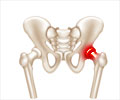- Bone Density Scan - (http://www.medicinenet.com/bone_density_scan/article.htm)
- OSTEOPOROSIS FACT SHEET - (http://www.dolcera.com/wiki/images/osteoporosis_factsheet.pdf)
About
Osteoporosis or thinning of bone results in decreased strength of bone. Though it does not cause any symptoms, it predisposes an individual to fractures especially of the wrist (Colle’s fracture), backbone (compression fracture of vertebra) and hip (fracture neck of femur) even with minor trauma. Thus, early detection of the condition using screening methods and early treatment helps to avoid fractures and its associated morbidity to the patients.
Worldwide, the risk of suffering from osteoporotic fractures is 30-50% in women and 15 to 30% in men.
In India, 1 out of every 3 women and 1 out of every 8 men suffer from osteoporosis. Thus, women are more prone to developing osteoporosis. Estrogens have a protective effect on bones; thus lack of estrogens during menopause plays an important role in the development of osteoporosis.
Other factors that increase a person’s risk for developing osteoporotic fractures include:
- Prior fracture in the individual or his/her close relatives
- Low body weight, thin stature or poor health
- Older age
- Cigarette smoking or Alcoholism
- Corticosteroid use for more than 3 months
- Estrogen deficiency at an early age due to conditions like early menopause
- Dementia
- Impaired eyesight
- Recent falls
- Low calcium intake
- Hyperthyroidism
- Rheumatoid arthritis
- Oral contraceptives
- Decreased physical activity
Osteoporosis Screening Test
Who should undergo screening for osteoporosis?
Osteoporosis screening is recommended for all women over the age of 65 years. It is also indicated in postmenopausal women below the age of 65 years who are at a risk for suffering from osteoporotic fractures. Other women or men may consult their doctor regarding the test in case they are at high risk for developing osteoporotic fractures.
How frequently does the screening test need to be repeated?
Though there are no definite recommendations for repeating the test in an individual who has had a negative test, it may be repeated after a minimum of 2 years.
How is screening for osteoporosis done?
Screening for osteoporosis is done using a Bone Mineral Density scan or a DEXA scan (Dual Energy X-ray Absorptiometry Scan). The scan measures bone density usually at the hips or the spine. The patient needs to lie still on the table while the scan is done. The density is measured in terms of a score called the T-score.
- T-score of less or equal to -2.5 indicates osteoporosis.
- T-score between -1 and -2.5 indicates a milder form of the disease called osteopenia. People in this range are at a high risk for developing osteoporosis.
Peripheral DEXA machines are also used that measure bone density at the heel, forearm and fingers. Quantitative ultrasound of the heel is also sometimes used in screening for osteoporosis.
Frequently Asked Questions
1) Which doctor should I see if my DEXA scan comes abnormal?
You should visit an Orthopaedic specialist or an Endocrinologist in case your DEXA scan is abnormal.
2) Can I get the DEXA scan done more frequently?
There are no specific recommendations regarding how often the DEXA scan should be done. However, if your test is negative, it will take a minimum of 2 years for the scan to detect any changes in your bone. Thus a more frequent DEXA scan would not be of much use.
3) Should men also undergo screening for osteoporosis?
Most guidelines do not currently recommended osteoporosis screening for men. However, men especially from the older age group should be repeatedly assessed for risk factors for developing osteoporosis. They should undergo screening if they are found to be at a risk for osteoporosis and osteoporosis-related fractures and if they could possibly benefit from treatment.
4) What are the possible harms of screening for osteoporosis?
The DEXA scan may not always give a 100% accurate result. If it suggests that the individual has osteoporosis when it is actually absent (false positive result), the individual may have to undergo unnecessary treatment. It could also cause anxiety to the individual. At the same time, a wrong negative result (false negative result) could deprive the individual of treatment.








